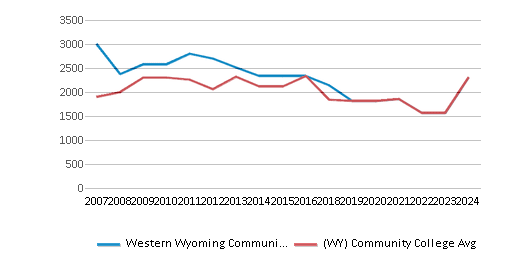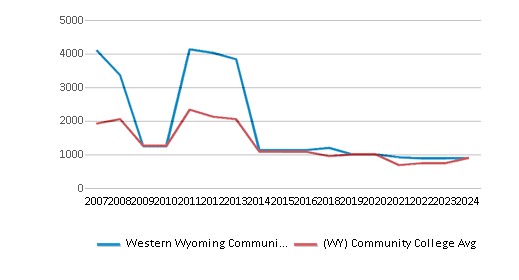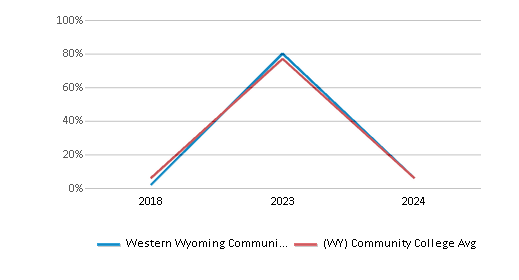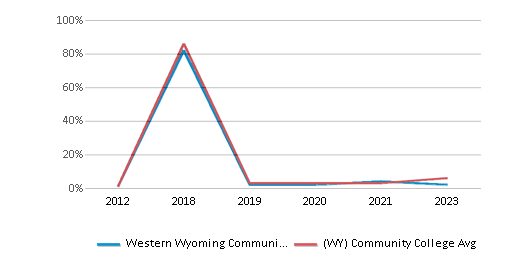- Western Wyoming Community College is under the control of a locally elected Board of Trustees responsible for governing Western Wyoming Community College District. It is a public, tax-supported, co-educational, two-year community college.
School Highlights
Western Wyoming Community College serves 3,207 students (28% of students are full-time).
The college's student:teacher ratio of 9:1 is lower than the state community college average of 11:1.
Minority enrollment is 23% of the student body (majority Hispanic), which is less than the state average of 27%.
Quick Stats (2025)
- Enrollment: 3,207 students
- In-state tuition: $2,400
- Out-state tuition: $6,384
- Student:teacher ratio: 9:1
- Minority enrollment: 23%
- Source: Integrated Postsecondary Education Data System (IPEDS)
School Overview
The teacher population of 351 teachers has stayed relatively flat over five years.
Western Wyoming Community College
(WY) Community College Avg.
Carnegie Classification
Associate's Colleges: High Career & Technical-High Nontraditional
Associate's Colleges: Mixed Transfer/Career & Technical-High Nontraditional
Institution Level
Four or more years
At least 2 but less than 4 years
Institution Control
Public
Public
Total Faculty
351 staff
245 staff

School Calendar
Student Body
The student population of Western Wyoming Community College has grown by 13% over five years.
The student:teacher ratio of 9:1 has increased from 8:1 over five years.
The Western Wyoming Community College diversity score of 0.38 is less than the state average of 0.45. The school's diversity has stayed relatively flat over five years.
Total Enrollment
3,207 students
2,377 students

Student : Teacher Ratio
9:1
11:1

# Full-Time Students
899 students
899 students

# Part-Time Students
2,308 students
2,308 students



# Enrollment Undergraduate
320 students
237 students
# Full-Time Undergraduate Students
899 students
899 students

# Part-Time Undergraduate Students
2,308 students
2,308 students
Total Dormitory Capacity
545 students
620 students

% American Indian/Alaskan
n/a
2%

% Asian
1%
1%

% Hispanic
16%
12%

% Black
1%
1%

% White
77%
73%

% Hawaiian
n/a
n/a

% Two or more races
4%
3%

% Non Resident races
1%
1%

% Unknown races
1%
7%


Diversity Score
0.38
0.45

College Completion Rate (Students who graduate in less than 4 years)
34%
0.8136%

College Completion Rate (Students who graduate in 4 years or more than 4 years)
0.3377%
0.3377%
Average Graduate Earnings (10 Years)
$41,400
$34,500

Tuition and Acceptance Rate
The public in-state tuition of $2,400 is less than the state average of $2,855. The in-state tuition has declined by 30% over four years.
The public out-state tuition of $6,384 is less than the state average of $6,991. The out-state tuition has declined by 22% over four years.
In-State Tuition Fees
$2,400
$2,855

Out-State Tuition Fees
$6,384
$6,991

% Students Receiving Some Financial Aid
88%
93%

Median Debt for Graduates
$9,323
$9,323

Median Debt for Dropouts
$3,500
$4,750

Sports
Total Sports Offered
4 sports
Sports
Basketball, Soccer, Volleyball, Wrestling
Source: 2024 (or latest year available) Integrated Postsecondary Education Data System (IPEDS) , School Administrators
School Notes
- Western's fundamental purpose is to provide high quality learning opportunities to students who are at various stages of life and have differing needs and expectations. Committed to quality and success, Western encourages flexibility, innovation, and active learning for students, faculty and staff. The College understands that learning occurs inside and outside the classroom and, therefore, seeks to create an environment where lifelong learning is encouraged and where students and employees interact in an atmosphere of mutual respect. Western Wyoming Community College, the fifth of seven community colleges in Wyoming, was established in the Fall of 1959. In 1960-61, the College moved to Reliance, five miles from Rock Springs, to occupy the former Reliance High School and daytime classes began. In September, 1964, the original district was expanded to include all communities within Sweetwater County. Consistent growth of the College led to the inauguration of a $1,822,000 building program on October 4, 1966. On November 11, 1967, ground-breaking ceremonies marked the beginning of construction on a new campus, and completion in June, 1969. Growth continued. In March, 1973, voters approved a $1,780,000 bond issue to provide additional instructional facilities. The new vocational-technical education building was ready for occupancy in Fall, 1974, and the college center building was completed. In 1976, three residence halls were constructed to provide on-campus housing, made possible by a loan from the State Farm Loan Board. The college offers Occupational and Transfer Programs in Arts & Performing Arts, Business, Computer Science and Office Information Systems, Education, Health, Humanities & Communication, Math & Science, Social Science, Technology & Industry Programs Technology & Industry Programs and General Studies. The college offers Associate of Applied Science (A.A.S), Associate of Arts (A.A.), Associate of Fine Arts (A.F.A.), Associate of Science (A.S.) degrees and One Year Certificate Programs and Certification Testing. Western Wyoming Community College is accredited by the North Central Association of Colleges & Schools.
Frequently Asked Questions
How much does Western Wyoming Community College cost?
Western Wyoming Community College's tuition is approximately $2,400 for In-State students and $6,384 for Out-State students.
What sports does Western Wyoming Community College offer?
Western Wyoming Community College offers 4 interscholastic sports: Basketball, Soccer, Volleyball and Wrestling.
Recent Articles

Obtaining Your Bachelor's Degree at a Community College
Explore the evolving landscape of community colleges offering bachelor's degrees, addressing affordability, accessibility, and workforce needs.

A to Z of Community College Certificates and Courses
From business and healthcare to technology and skilled trades, the article showcases the breadth of options available to students seeking to enhance their knowledge, develop new skills, or pursue career advancement.

What is a Community College?
This comprehensive guide explains what a community college is, its history, and its role in higher education. It covers the types of programs offered, differences from four-year colleges, benefits of attending, and important considerations for prospective students, providing valuable insights for those exploring educational options.



















